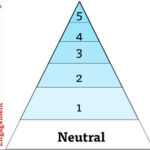In 1943, American psychologist Abraham Maslow published an article in Psychological Review titled, “A Theory of Human Motivation.” Maslow proposed that humans have five levels of needs that build in sequential order. The needs are (in order), physiological, safety, social, self-esteem, and self-actualization. For a human to care about self-actualization, the other four needs are prerequisites. Similar to Maslow’s Hierarchy of Needs, in the Dance Floor Theory Engagement Pyramid, each stage of a person’s engagement within a community has a specific need that has to be fulfilled to allow them to progress to the next level of engagement.
Here are the six engagement needs based on our DFT Engagement Pyramid:
Need for Interruption
Neutrals are the hardest group to engage past their current level as a Neutral. Sadly, they are also usually the largest group within any community. Remember, Gallup estimates that around 60% of employees fall into this category. Neutrals are so hard to engage because their daily habits run their life. For the most part, a play-not-to-lose, fixed mindset has created these habits. They don’t really have any desire to change, nor are they seeking any growth for themselves or their career. The goal at this stage is to place a “pattern interrupt” into their day, as a way to get their attention. I know it may sound simple, but it is surprisingly hard to get the attention of someone who isn’t used to paying attention. But this interruption is required to get them to move to the next step of engagement.
Need for Connection
1s are paying attention, but need something to grab onto. The most important thing you can do for a 1 is to build a relationship with them. Make them feel like you care and are there to help them. If they feel like they have at least one social connection within the community, they will stick around. As a Neutral, they were well within their comfort zone and didn’t face any risk. As a 1, they are opening themselves up to new ideas, which their brain will perceive as a risk. But having a connection with you will help them feel more comfortable at this stage. Now that you have a connection with them, and they feel comfortable with you, they will also pay attention to what you have to say or offer, which brings us to the next step of engagement.
Need for Materialistic Value
2s want to be active participants in the community, but they do so from the selfish standpoint of what they can gain out of it. Their motivation is about themselves. They will attend an event if there is free food. They will join a committee if it makes them look good. They will agree to do something for you, if you agree to do something for them in return. As bad as this stage might sound, it’s okay, and a natural progression that leads the person to the next step of engagement.
Need for Responsibility
3s no longer care about doing something just because they gain selfishly from it. 3s seek out more involvement because they actually enjoy doing it. They desire to take on more lower level responsibilities within their current role. This expansion of smaller commitments is what leads them to the next step of engagement.
Need for Ownership
4s don’t just want to be a supportive role to someone else’s leadership, they want to own the project. They want to be able to say, “the buck stops with me.” 4s want to show everyone that if you put them in charge of something, it will get done and done right. While 4s have a scope of vision that is more focused within their own personal abilities, this level of ownership is what leads them to the next step of engagement.
Need for Leadership
5s seek to lead others. 5s desire to be put into leadership positions where their success is dependent on making others successful. They want to be a part of the bigger-picture planning, because they no longer care only about their own role; they care about the whole organization.
While the needs of each group are distinct, the traits of each need overlap between bordering levels. For example, you’ll find 4s who start to dabble into needs of leadership. Or you’ll find 1s who volunteer for something because they get a free trip out of it. However, the further the levels are from each other, the less you’ll see overlapping needs to show up. You won’t see a 5 care about a free trip like a 2 would.
The six needs listed above help us to continue to frame a model of engaging each level, with the ultimate goal of increasing the overall engagement of the entire organization.



